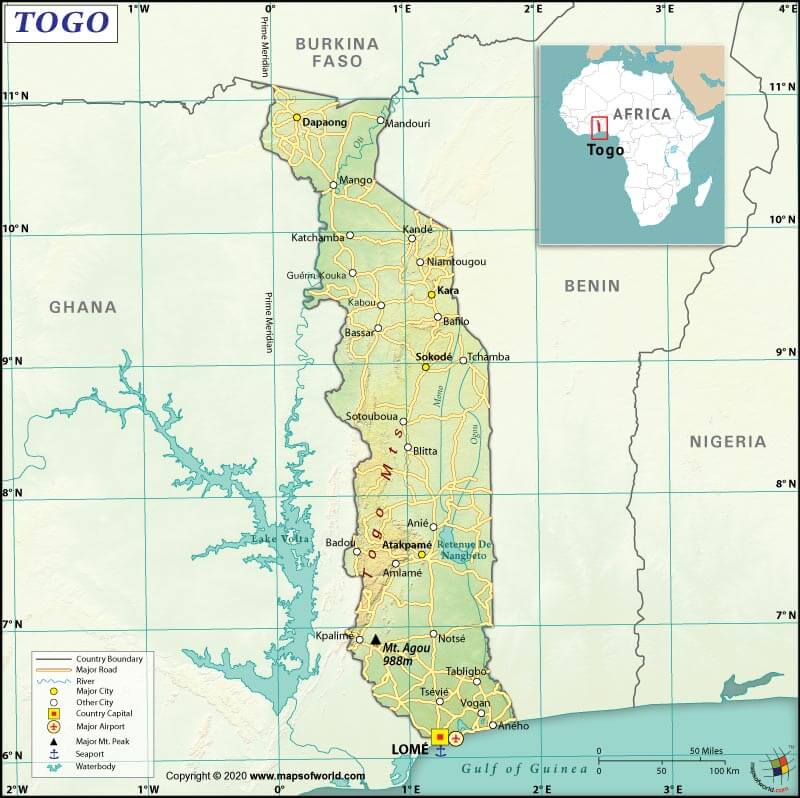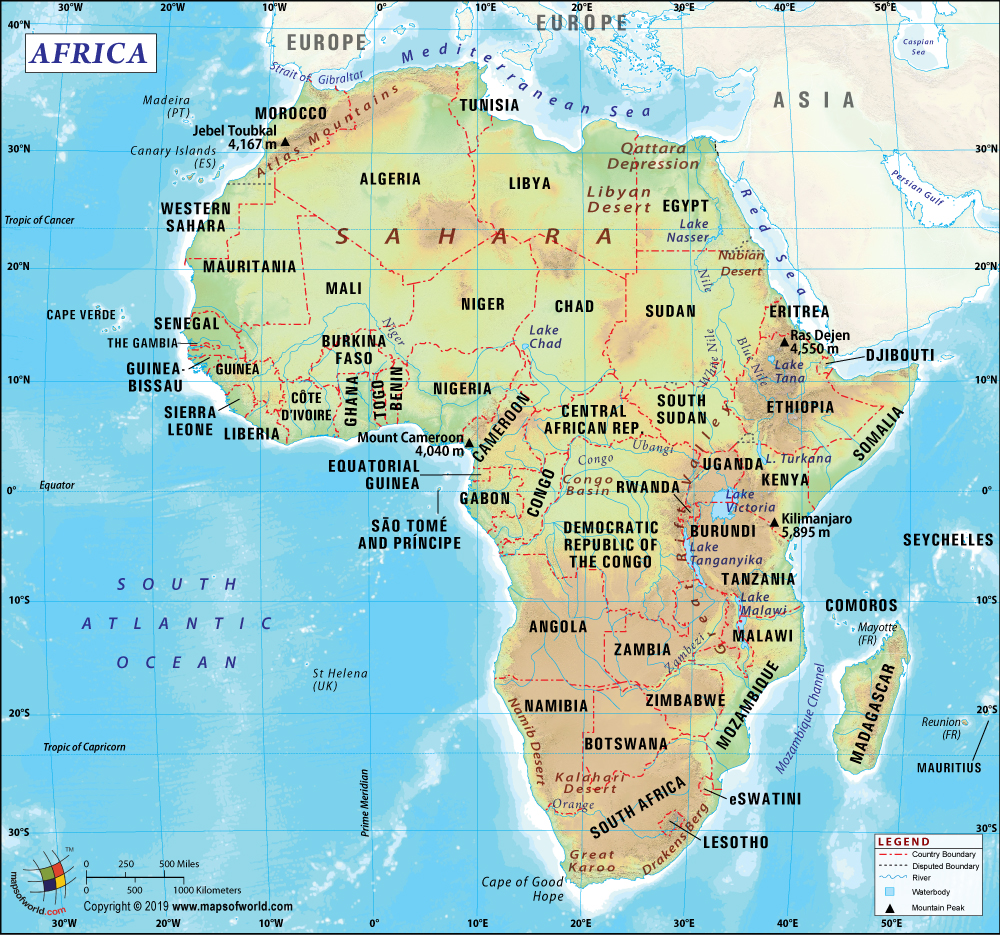What are the Key Facts of Togo?

|
Official Name |
Togolese Republic |
|
Continent |
Africa |
|
Capital |
Lomé |
|
Largest City |
Lomé |
|
Coordinates |
8.000000, 1.166667 |
|
Area |
21,925 sq. mi (56,785 sq. km) |
|
Land Boundaries |
1,168 mi (1,880 km) |
|
Coastline |
35 mi (56 km) |
|
Currency |
West African CFA franc (XOF) |
|
Neighboring Countries |
Benin, Burkina Faso, Ghana |
|
Population |
8,082,370 (World Bank, 2019) |
|
Official Languages |
French |
|
Major Religion |
Christianity |
|
National Day |
27 April (Independence Day) |
|
National Anthem |
“Salut a toi, pays de nos aieux” |
|
Form of Government |
Presidential republic |
|
President |
Faure Gnassingbé |
|
Prime Minister |
Komi Sélom Klassou |
|
GDP per capita (PPP) |
$ 1,662.1 (World Bank, 2019) |
|
GDP per capita (nominal) |
$ 675.5 (World Bank, 2019) |
|
HDI |
0.513 (2019), Rank: 167 |
|
Literacy Rate (%) |
84.29 (UNESCO, 2015) |
|
Space Agency |
NA |
|
Military Expenditure Ranking |
114 (SIPRI, 2019) |
|
No. of Olympic Medals |
1 (as of 2018) |
|
Driving Side |
right |
Calling Code |
228 |
|
Time Zone |
UTC (GMT) |
Internet TLD |
.tg |
Where is Togo?
Togo (whose official name is the Togolese Republic) is a West African country located between Ghana and Benin, bordering the Bight of Benin.
What is the Geography of Togo?
Togo spreads across a total area of 56,785 sq. km (21,925 sq. mi). Out of the total area, 54,385 sq. km (20,998 sq. mi) is land, and 2,400 sq. km (927 sq. mi) is water. It is one of the smallest countries in the world. It is also one of the narrowest countries with less than 115 km (71 mi) in width.
The total land boundary of Togo is 1,880 km (1,168.2 mi) long, which is shared with three countries: Ghana (1,098 km or 682.3 mi) to the west, Benin (651 km or 404.5 mi) to the east, and Burkina Faso (131 km or 81.4 mi) to the north. Togo has a 56 km (34.8 mi) long coastline.
The mean elevation of the country is 236 m (774.3 ft). While the highest point is Mont Agou at 986 m (3,234.9 ft), the lowest point is the Atlantic Sea at 0 m (0 ft).
Togo’s terrain is extremely diverse. In the northern part of the country, the landform is dominated by gently rolling savanna. Hills are mainly situated in the central region. While the plateaus are mostly situated in southern Togo, extensive lagoons and marshes are found in the low coastal plain.
The tidal flats and shallow lagoons back the low-lying, sandy beaches on the narrow coast of Togo. Lake Togo is the largest lagoon in this country. As you move inland, you will find the Ouatchi Plateau, whose stretch is around 32 km (20 mi) inland. This plateau has an elevation of about 60-90 m (200-300 ft). Ouatchi Plateau has a lateritic soil, which is characterized by reddish color. The region is known as Terre de barre.
A tableland, having the highest elevation of around 400-460 m (1,300-1,500 ft), is located in the northeast of the plateau. Mono River and its tributaries drain the region.
The landform starts rising as you move to the west and southwest of the tableland. It rises towards the Togo Mountains, which is also called Togo-Atakora Mountains. This mountain runs from south-southwest to the north-northeast across central Togo.
You will find the Oti River sandstone plateau to the north of the Togo Mountains, which is a savanna region. One of the main tributaries of the Volta River, the Oti River, drains this region. The cliffs of Dapaong are located in the far northwest. These cliffs are made up of granite and gneiss.
The highest mountains in the country are Mont Agou and Mont Sokbaro. There are three main rivers: Volta River, Mono River, and Zio River. Some of their main tributaries are the Todzie River, Oti River, Mo River, Kara River, Couffo River, etc.
What is the Climate of Togo?
A tropical climate is found in the country. In the southern region of the country, two rainy seasons are found. While one lasts from mid-April to June, the latter lasts from mid-September to October.
Togo’s narrow coastal region is the driest region as it receives just 890 mm (35 in) of annual precipitation. The highest precipitation is received in the area near Palimé, which is located around 100 km (65 miles) inland. It receives annual precipitation of approximately 1,800 mm (70 in).
The northern region of the country receives just one rainy season. It mainly lasts from June to the end of September. The amount of precipitation in this area generally hovers around 1,150 mm (45 in). It remains warm and dry in the north during the rest of the year. A dust-laden wind harmattan predominantly blows during this time.
The average yearly temperature varies from one region to another. While it remains around the low 80s °F (high 20s °C) in the northern plateau, it hovers around the high 70s °F (mid-20s °C) in the coastal and mountainous regions.
In August, the daily minimum temperature in the mountains reaches the high 60s °F (low 20s °C). During March-April, the daily maxima hover around the low 100s °F (high 30s °C).
What is the Economy of Togo?
The economy of the country has made a rapid recovery after attaining political stability. Rapid expansion in commercial infrastructure (which includes new principal roads, a new airport terminal, and a new seaport) and a concerted effort by the government to modernize the country has helped the economy grow rapidly.
Commercial and subsistence agriculture are the main employers (employing 60% of Togo’s total labor force). Cotton is the main cash crop of the economy. 20% of export earnings come from the export of cotton, coffee, and cocoa. IMF considers Togo as one of the poorest countries in the world.
The nominal GDP of the country grew at an annual rate of 5.313% to US$5.46 billion in 2019. The export and import values of the country in 2018 were US$2.53 billion and US$10.6 billion, respectively.
The major exports are Refined Petroleum, Gold, Crude Petroleum, Other Oily Seeds, and Cement. The major imports of Togo are Refined Petroleum, Light Pure Woven Cotton, Broadcasting Equipment, Motorcycles, and Palm Oil.
The unemployment rate has dropped from 4.23% in 2006 to 2.04% in 2019. The rate of poverty is more than 50%. Togo is classified both as a Least Developed Country (LCD) as well as a Low Income Food Deficit Country (LIFDC).
What is the Transportation System of Togo?
The country has eight airports, out of which two have paved runways, and 6 have unpaved runways. Major airports are Lomé-Tokoin Airport (Gnassingbé Eyadéma Int’ l) in Lomé, Niamtougou International Airport in Niamtougou, Kolokope Airport in Anié, and many more.
Togo has 568 km (352.9 mi) long narrow-gauge railways. There is 50 km (31.1 mi) of waterway available in the country. Lome and Kpeme are the major seaports of Togo. There are 405 merchant marine vessels in the country, out of which 266 are general cargo, 50 oil tankers, five container ships, five bulk carriers, and 79 are other types of vessels.
What International Organizations is Togo Part of?
WTO, IMF, UN, WHO, ILO, NAM, ACP, AfDB, AU, ECOWAS, Entente, FAO, FZ, G-77, IAEA, IBRD, ICAO, ICRM, IDA, IDB, IFAD, IFC, IFRCS, IMO, Interpol, IOC, IOM, IPU, ITSO, ITU, MIGA, MINURSO, MINUSMA, OIC, OIF, OPCW, PCA, UNAMID, UNCTAD, UNESCO, UNHCR, UNIDO, UNMIL, UNOCI, UNWTO, UPU, WAEMU, WCO, WFTU (NGOs), WIPO, WMO, EITI (compliant country), ISO (correspondent), WADB (regional), ITUC (NGOs)
Related Maps:



